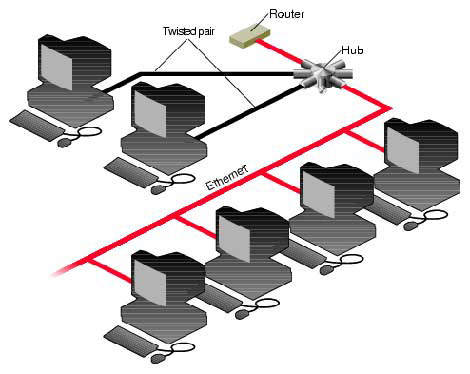Ethernet is a standard of network communication using twisted pair cable although coaxial cable was used in older versions of Ethernet. Ethernet was developed in 1973 by Bob Metcalfe at Xerox. It is the most widely used standard in network communication and run at 10 to 1000 megabytes per second (Mbps) with 1Gbps speed now becoming standard.
The IEEE standard 802.3 is used for Ethernet but it has several different types or versions starting with the original 10base5 version. The 10 stands for 10Mbps and base describes the Baseband communications it uses. The 5 stands for a maximum distance of 500 meters which is how far the signal can travel before having to be repeated or regenerated. This type of Ethernet used coaxial wiring instead of the newer versions that use twisted pair cabling. Other types of Ethernet include 10Base2, 10BaseT and 100BaseT which is the most common type in use today. 10BaseT offers 100 Mbps with a distance of 100 meters and uses twisted pair cabling.

On an Ethernet network when a computer sends out a packet destined for another computer then generally every computer on the network segment will get that packet and the computers that it doesn’t belong to will reject the packet. If you have a large network then this can start to take its toll on your bandwidth if every computer (node) has to receive the packet. If you are using switched Ethernet then the switch picks up every transmission before it reaches another node. The switch then forwards the data over the appropriate segment but the data only reaches the intended recipient.
Most networks today use Full Duplex Ethernet which allows the network card to send and receive data at the same time. Older systems utilized Half Duplex which only allowed data to move one direction at a time between devices.
CSMA/CD (Carrier Sense Multiple Access with Collision Detection) was implemented to help cut down on collisions of packets caused by 2 or more computers sending data down the wire at the same time. Before a station transmits, it listens to the medium/cable to determine if another station is transmitting. If the medium is quiet, the station recognizes that it is ok to transmit the data. A single Ethernet segment is sometimes called a collision domain because no two stations on the segment can transmit at the same time without causing a collision.
Larger Ethernet networks are often broken down into multiple segments or subnets to keep traffic and collisions at a minimum. When a computer sends a packet out to its own subnet then it will stay on that subnet unless it is addressed to a different subnet. Then a router will take that packet and forward it to the appropriate subnet. The way that the network determines what subnet the packet is going to is based on the destination IP address within the packet.
The most common Ethernet cabling in use today is Category 5e (or Cat5e) UTP (Unshielded Twisted Pair). This cable type utilizes 4 pairs of twisted-pair wires within one cable. The2 pairs are used to send data and 2 pairs are used to receive data. There is also a Shielded Twisted Pair (STP) but it is more expensive and harder to work with because of the shielding. Cat5 cables use an RJ-45 connector on the end which looks like a phone cord connector only larger. Cat5e is a newer type of Cat5 cabling that supports 1Gbps connections where standard Cat5 only supports 100Mbps. Cat6 is the same as Cat5e except that it is made to a higher standard and increases the bandwidth from 100MHz to 250MHz. and Cat7 is becoming more common as well.







